Main content starts here.
Foreign Languages > Chiba International Information Square - To foreign residents - > Chiba Nanohana News > Chiba Nanohana News (Past Issues) > Chiba Nanohana News (March 2023)
Update: March 23, 2023
Chiba Nanohana News (March 2023)
Index
I. News II. Festivals and Events
I. News
1) Disaster Preparedness
The Great East Japan Earthquake that struck Japan on March 11, 2011, was the most unprecedented natural disaster in modern Japanese history. The earthquake and following tsunami caused extensive damage to the affected areas and confusion throughout the entire country.
Japan is one of the most earthquake-prone countries in the world. Since we don’t know when a major earthquake will occur, it is important to prepare ourselves in advance to minimize the damage that can be caused by a natural disaster. Please go over what you should do when it’s time to take action.
If an Earthquake Strikes
1. Pre-Earthquake Warning
A warning notification may be sent out before an earthquake is about to strike.
Prepare to protect yourself in this short amount of time before the earthquake occurs.
2. Earthquake
Protect yourself by crouching under a table or desk and wait until the shaking stops.
3. When the Shaking Stops
Evacuate immediately if you are in an area prone to tsunamis or mudslides.
Put out any open flames (i.e. gas stove) and open your doors and windows to secure an escape route.
4. Evacuation & Ensuring the Safety of your Family
Check for accurate information on the radio or other broadcasts methods. If your house is in danger of collapsing, evacuate immediately. Put on your shoes, take your emergency kit, and evacuate on foot. Make sure to turn off your circuit breaker before you evacuate. If you have a seismic breaker in place, it will automatically turn your breaker off for you.
Check on the safety of your family members who aren’t currently with you. If possible, avoid using your phone, and use a disaster messaging service instead.
- Disaster Emergency Message Dial <171>

- Web171

- Mobile phone versions of Disaster Emergency Message Dial
5. Emergency Response
In the event of a large disaster, emergency responders will most likely be unable to come to your aid right away. As you are able, work with the people around you to put out fires and make efforts to rescue others. Be sure to participate in disaster prevention drills on a regular basis in order to practice beforehand.
6. Evacuation Shelters
Evacuation shelters are located in each municipality and are open to anyone, free of charge. It is also possible to stay there overnight.
Gather the latest information through the radio or other form of broadcast.
While food will be provided, use up your stockpiled supplies first. Make sure to help each other at the evacuation shelter with the members of your local disaster prevention organization.
Tsunami
Since Chiba Prefecture is surrounded by water on three sides, there is also risk of a tsunami occurring in the event of an earthquake.
<What You Should Know about Tsunamis>
- In the event of a strong earthquake or a weak earthquake with slow, prolonged shaking, move away from coastal areas and evacuate to a high place.
- Even if you don't sense an earthquake, evacuate immediately if a tsunami warning is sent out.
- Tsunami waves hit repeatedly, so stay evacuated until the tsunami warning has been lifted.
Advance Preparations
Preparing a Stockpiled Supply
Stockpile food on a regular basis, using the oldest first and replenishing what you have used up. A portable gas stove is a good way to prepare hot meals.
(Examples of supplies to stockpile)
- Water (a week’s supply, 3 liters per person per day), portable gas stove, gas cylinder, food (rice, cup noodles, pre-packaged food, snacks, etc.)
- Handheld radio, portable toilet, cellphone battery, flashlight, trash bags
- Essential medication, sanitary products, powdered milk, diapers, etc.
(Examples of emergency goods)
- water, emergency rations, household medication
- cellphone battery, flashlight, helmet, protective hood
- cash, bankbook, personal seal
- towel, change of clothes, mask, raingear
- tissues, lighter, candles, trash bags, etc.
Earthquake-Proofing, Securing Furniture, and Seismic Breakers
If you live in an old or wooden building or on reclaimed land, have a seismic inspection conducted in order to strengthen your building's earthquake resistance. Make sure that large furniture is securely placed. Avoid placing large furniture in bedrooms or children's rooms. Place your furniture within your home so that it doesn’t obstruct potential evacuation paths. Put film on your windows to prevent damage from flying objects.
When a seismic breaker senses shaking, it will automatically shut off electricity to the breaker and power outlets. It is effective in preventing electrical fires.
Identifying Hazardous Areas and Evacuation Shelters
Identify areas that are susceptible to flooding or mudslides in the event of a tsunami by checking your municipality's hazard map. Find safe roads and evacuation shelters to ensure you can evacuate safely. Your evacuation site may be different for tsunamis or heavy rains.
Disaster Prevention Information
◇ Chiba Prefecture disaster prevention portal site (in Multiple Languages)![]()
◇ “Safety Tips” (a tap-enabled information alert app for international visitors in Multiple Languages)
◇ Multilingual Emergency Updates (NHK World-JAPAN)![]()
II. Festivals and Events
1) Cherry Blossom Viewing Spots in Chiba
“Hanami,” or cherry blossom viewing, is a popular spring activity in Japan with a long history as a traditional practice. Cherry blossoms are called “sakura” in Japanese and are by far the most anticipated flower every spring. When they are in bloom, many people gather to take walks or have picnics under the trees, enjoying the brief one to two-week period that these beautiful flowers can be seen every year.
Izumi Nature Park(Chiba City)
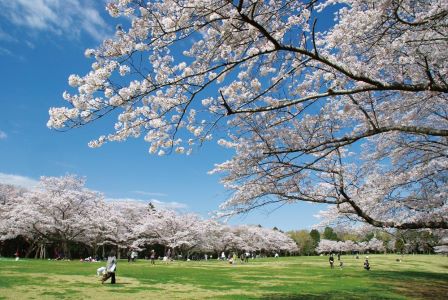
Izumi Nature Park is officially recognized as one of Japan’s Top 100 Cherry Blossom Spots. The best views can be enjoyed at the “Sogen” (Meadow) and “Ohanami Hiroba” (Cherry Blossom Square) areas within the park.
- Peak Season: late March to early April
- Scale: about 1,500 trees
- Blossom Varieties: Somei Yoshino, Yama-zakura, Shidare-zakura
- Location: 108 Norocho, Wakaba-ku, Chiba City
- Access:【By Train/Bus】From the JR Chiba Station East Exit Bus Terminal, take the bus bound for either Naruto Station or Nakano Soshajo at Bus Stop 10, then get off at the Izumi Koen Iriguchi Bus Stop and walk 10 minutes
【By Car】Exit Chiba-Togane Road from the Takada IC (Interchange) and turn left. Drive towards National Road 126 (Chiba-Togane Road) for about 1 kilometer, and the park will be on the left (paid parking available) - Contact: Chiba City Wakaba Park Greenery Office TEL:043-306-0101
Akebonoyama Park(Kashiwa City)
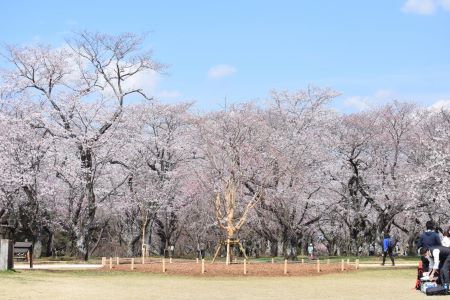
Akebonoyama Park’s “Sakurayama” is a well-known place to see cherry blossoms. Fuse-Benten Tokaiji Temple launched a cherry blossom tourism project there in the mid-Edo period (1603-1867), and many people have come out in crowds to enjoy the park since that time. In April 2022, the park breathed new life into Sakurayama by cutting down the withered Somei Yoshino cherry trees, planting new trees, and improving the garden paths.
The newly-planted tree varieties include the disease-resistant “Jindai-akebono,” the “Accolade” which bloom in both spring and autumn, and the “Shidare-zakura” which serve as the focal point of the park.
- Peak Season: late March to early April
- Scale: about 350 trees
- Blossom Varieties: Jindai-akebono, Accolade, Shidare-zakura, Somei Yoshino, Yama-zakura
- Location: 1940 Fuse, Kashiwa City
- Access:【By Train/Bus】From Abiko Station on the JR Joban Line, take the bus bound for Akebonoyama Koen Iriguchi, then get off at the last stop and walk 7 minutes
- Contact: Akebonoyama Agriculture Park Main Office TEL:04-7133-8877
Sakae Cherry Blossom Festival/Doramu no Sato(Sakae Town)
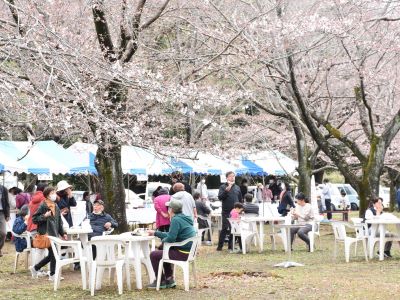
From March through April, the Kawazu-zakura and Somei Yoshino blossoms are in full bloom on the grounds of “Doramu no Sato.” Every year, the “Sakae-machi Sakura Matsuri” (Sakae Cherry Blossom Festival) is held in conjunction with the blooming of the cherry blossoms and features booths selling local products, mini concerts, and other festivities. In addition, the adjacent Chiba Prefectural Boso no Mura Open-Air Museum will be holding a cherry blossom festival at the same time, turning the entire area into one exciting event to come and enjoy.
*food stalls, flea market, food truck vendors
*mini live concerts by amateur bands, street performances (Saturday, March 25)
*mini live concert by the Chiba Prefectural Police Band, police vehicles on display, mini live concerts by amateur bands (Sunday, March 26)
- Duration: Saturday, March 25 to Sunday, March 26
- Time: 10 am – 3 pm
- Location: Doramu no Sato/1039-1 Ryukakuji, Sakae Town, Imba District
- Admission: Free (Boso no Mura has paid admission)
- Access:【By Train】Take the JR Narita Line to Ajiki Station
- Contact:Doramu no Sato Cosplay Hall TEL:0476-85-8155
Omigawa Joyama Park(Katori City)
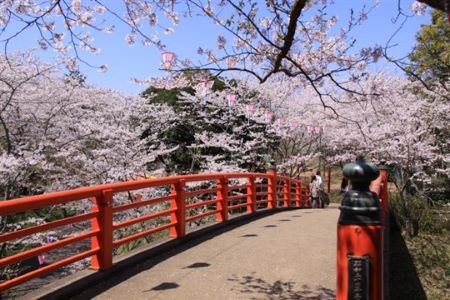
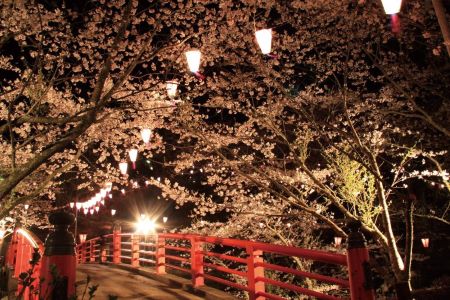
The “Suigo Omigawa Sakura Tsutsuji Matsuri” (Suigo Omigawa Cherry Blossom and Azalea Festival) will be held from Wednesday, March 21 to Sunday, May 7. One of the festival highlights is that the trees will be lit up at night while the cherry blossoms are in bloom (late March to mid-April, 6 pm – 10 pm). Also, on Sunday, April 2, visitors can enjoy a variety of events including an “Ohanami Concert” (Cherry Blossom Viewing Concert) and “Yosakoi Naruko Odori” performances, a Japanese style of festival dance.
- Peak Season: early April
- Scale: about 1,000 trees
- Blossom Varieties: Somei Yoshino、Shidare-zakura, and more
- Location: 431 Omigawa, Katori City
- Access:【By Train】Take the JR Narita Line to Omigawa Station and walk 20 minutes
- Contact: Suigo Omigawa Tourism Association TEL:0478-50-1212
Sakura Castle Park(Sakura City)
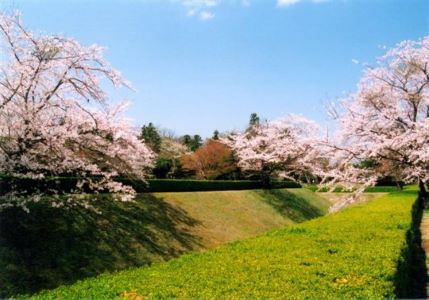
“Sakura Joshi Koen,” or Sakura Castle Park, is the sole site within Chiba Prefecture that’s included on the Top 100 Japanese Castles list. It is also a designated Japan Heritage cultural property as “Edo Travelogue through Four Hokuso Cities,” one of four northern cities in Chiba that supported the ancient mega-city of Edo. The park has around 1,100 cherry trees and 50 varieties that will be blooming in their full glory, including 13 varieties that have been called famous since the Edo period.
Visitors can witness beautiful scenes of the castle and cherry blossoms at the Honmaru ruins, Umadashi-karahori (the dry moat), and the reflection of the Somei Yoshino blossoms on the water of the Demaru ruins.
Food, beverages, and Sakura City’s local specialties will also be sold during the festival.
- Peak Season: late March to early April
- Scale: about 1,100 trees
- Blossom Varieties: Somei Yoshino and more
- Location: Kanyu-mubanchi (government-owned land), Jonaicho, Sakura City
- Access:【By Train】Take the JR Sobu Main Line to Sakura Station or the Keisei Main Line to Keisei-Sakura Station and walk 20 minutes
- Contact: Sakura City Parks and Greenery Division TEL:043-484-6165
Togane Cherry Blossom Festival/Hakkaku Lake(Togane City)
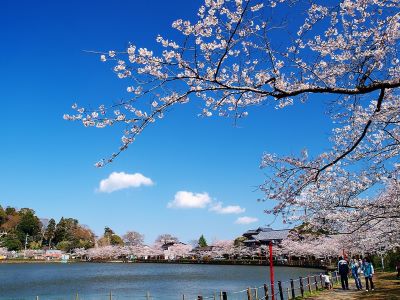
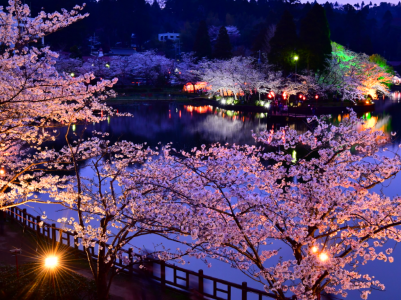
Approximately 300 Somei Yoshino trees will be in full bloom along the 800-kilometer perimeter of Hakkaku Lake. At night, the trees will be beautifully illuminated. The city plans to hold a variety of events during the festival and looks forward to welcoming visitors.
- Duration: Monday, March 27 to Sunday, April 9
- Location: Hakkaku Lake/1435-1 Togane, Togane City
- Access:【By Train】Take the JR Togane Line to Togane Station and walk 5 minutes
※ Traffic is restricted during the festival - Contact: Togane City Tourism Association TEL:0475-50-1142
Odayama Park(Kisarazu City)
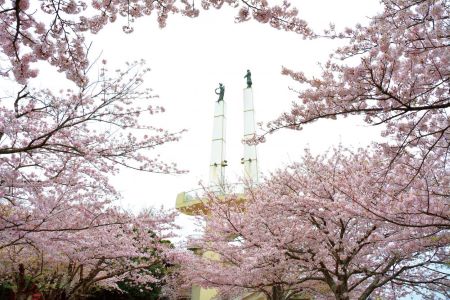
The summit of Odayama Park, also known as “Koi no Mori” (Forest of Love) from the legends of Yamato Takeru, will be completely colored in the light pink of flowering cherry blossoms. The trees will also be lit up a night from late March to early April. From Kimisarazu Tower, the summit offers panoramic views of the Tokyo Bay Aqualine, night views of Kisarazu City, and the Yokohama night skyline on the other side of Tokyo Bay. On clear days, Tokyo Sky Tree is also visible from this spot.
- Peak Season: late March to early April
- Scale: about 400 trees
- Blossom Varieties: Somei Yoshino, Oshima-zakura, Shidare-zakura, Yaezakura, Kamatari-zakura, Kawazu-zakura
- Location: 2-16 Oda, Kisarazu City
- Access:【By Train/Bus】From the East Exit of Kisarazu Station on the JR Uchibo Line, take a bus for about 4 minutes, then get off at the Koi no Mori Bus Stop and walk 5 minutes
